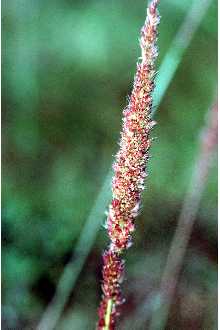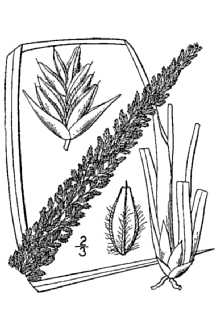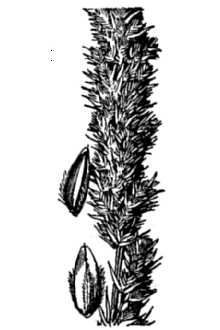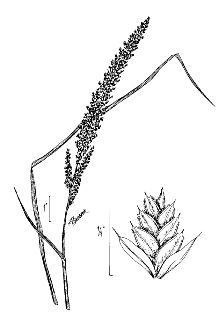Triodia stricta (Nutt.) Benth. ex Vasey
Scientific Name: Triodia stricta (Nutt.) Benth. ex Vasey

| General Information | |
|---|---|
| Usda Symbol | TRST11 |
| Group | Monocot |
| Life Cycle | Perennial |
| Growth Habits | Graminoid |
| Native Locations | TRST11 |
Plant Guide
Alternate Names
Common Alternate Names: Long-spike tridens (Diggs, 2006).
Uses
Landscaping: Longspike tridens shows excellent potential as a pioneer species for soil stabilization in disturbed areas due to its ability to tolerate wide ranges of environmental conditions including low fertility and salinity (Smith, 1996), excellent germination, and good seedling vigor. Forage: Longspike tridens has moderate palatability and is grazed to some extent by livestock (USDA NRCS, 2013). Longspike tridens may provide forage in marginal areas where more desirable species have difficulty surviving.
Status
Please consult the PLANTS Web site and your State Department of Natural Resources for this plant’s current status (e.g., threatened or endangered species, state noxious status, and wetland indicator values).
Description
General: Longspike tridens is a short lived, warm season, perennial, bunchgrass. As its name suggests, it produces a compact seed head on a long, “spike” like stalk. The seed heads are 4-12 inches in length and a half inch in width (Gould, 1975). Mature plants are between 2 and 5 feet in height, and produce smooth flat blades up to 20 inches long. Small hairs, or pubescence, are located on the upper surface of the leaves, near the base of the stem. The seed head, or panicle, may also have a hint of purple coloration. Distribution: Longspike tridens is widely distributed throughout the southeastern United States. It can be found as far north as Illinois and Pennsylvania and westward across Texas (Gould, 1975). For current distribution, please consult the Plant Profile page for this species on the PLANTS Web site. Habitat: This species will tolerate a wide range of soil conditions, however, it favors coarse to medium textured soils. It is commonly associated with upland areas, but is also a component of coastal grasslands (Smith, 1996). This species will tolerate moist areas as long as the soil does not stay inundated with water.
Adaptation
It is often present in disturbed areas such as road side ditches and rights- of- way, and can tolerate soil pH conditions between 3.5 to 7 (USDA NRCS, 2013).
Establishment
Seedbed preparation should begin well in advance of planting. Establish a clean, weed free seedbed via mowing, tillage, burning, broad spectrum herbicides, or a combination of these practices. It should be noted that tillage can greatly increase competition from annual, warm season weeds, reduces soil moisture, decreases organic matter, and hinders water infiltration properties of the soil. A preferred method of establishment is to no-till the seed into a stale seedbed that has been treated with a broad spectrum herbicide, mowed, and/or burned prior to planting. If tillage is performed in the spring, allow rains to create an initial flush of weeds. Treat germinated weed seedlings with a broad spectrum herbicide then plant the seed no-till into the chemically treated seedbed. The goal is to reduce weed competition and lessen soil disturbance prior to the target planting date. Apply P and K fertilizer based on soil test recommendations. Avoid nitrogen fertilizer until the second growing season or until a stand is evident. Applying nitrogen during the establishment year will increase competition from undesired warm season annuals. Seed may be broadcast or drilled into a well prepared, firm seed bed in spring at a rate of 0.71 PLS/acre. Planting depth should not exceed ¼ inch. The seed of this species is very small, having approximately 2,138,000 seeds per pound (USDA NRCS, 2013). Due to the size of the seed, it should be handled in a similar manner as small seeded legumes such as clovers. When broadcast seeding, it may be necessary to mix the seed with a spreading agent such as sand to help evenly distribute the seed, and a light drag or cultipacker should be used to cover the seed.
Management
Longspike tridens is moderately tolerant of burning. Depending on the intensity of the fire, the seed spike may or may not be removed. Clipping in the fall is sometimes helpful to remove the long seed spike. Longspike tridens grows on low fertility moist soils (Smith, 1996 and Kansas State University, 2013), making this a hearty and persistent species once established. The seed requires no stratification process before planting, and shows excellent seedling vigor. It is capable of reseeding itself under ideal conditions (Missouri Botanical Garden, 2013).
Pests and Potential Problems
There are no known significant pests or disease problems for this species.
Environmental Concerns
Concerns
Concerns
There are no known environmental concerns associated with longspike tridens.
Seeds and Plant Production
Plant Production , Use soil moisture sensors to measure the soil moisture of Triodia stricta (Nutt.) Benth. ex Vasey.
Plant Production
Longspike tridens is planted on 40” rows for seed production at the USDA-NRCS East Texas Plant Materials Center. Cultivation or herbicides are recommended to control weeds in established stands. Consult your local extension weed specialist for recommended herbicides. Longspike tridens flowers from July to November and produces seed in fall (Gould, 1975). Seed is harvested with a Native Seedster® or conventional combine. When harvesting with a Native Seedster® set the brush speed to ~ 112 RPM and comb speed to ~ 80 RPM. Use slow travel (<5 MPH) and approximately 850 RPM, when harvesting with a conventional combine. Air dry the harvested material before further processing. Once the seed is dried, it is roughly cleaned with a 2 screen scalper to separate stems and chaff. After the material is separated, a 3 screen laboratory seed cleaner is used for the final cleaning. Seed harvests vary from 23 to 58 lb. /acre of cleaned seed. Germination tests (settings at 680F/860F and 8 hrs. light) have showed this species to have excellent germination. Tests on seed lots from 2003 and 2005 produced 71 and 90% germination respectively. Cultivars, Improved, and Selected Materials (and area of origin) There are no known improved cultivars for this species at this time.
References
Diggs, G.M., B. Lipscomb, M. Reed, and R. O’Kennon. 2006. Illustrated Flora of East Texas Vol.1 Botanical Research Institute of Texas. Fort Worth, TX. Gould, F.W. 1975. The Grasses of Texas. Texas A&M University Press. College Station, TX. Kansas State University. 2013. Grass key for Tridens strictus [Online]. Available at http://spuds.agron ksu.edu/ksgrasskey/images/Tridensstrictus html (accessed 27 June 2013). Kansas State University, Manhattan, KS. Missouri Botanical Garden. 2013. Information sheet-Tridens strictus [Online]. Available at www.missouribotanicalgarden.org/gardens-gardening/your-garden/plant-finder/plant-detainls/kc/g790/tridens-strictus.aspx (accessed 17 June2013) Missouri Botanical Garden, St. Louis, MO. Smith, L. 1996. The Rare and Sensitive Natural Wetland Plant Communities of Interior Louisiana. Louisiana Department of Wildlife and Fisheries. Baton Rouge, LA. USDA NRCS Plants Database. 2013. Tridens strictus Plant Characteristics. Greensboro, NC. Prepared By: R. Alan Shadow and Melinda Brakie, East Texas Plant Materials Center, Nacogdoches, TX Citation Shadow, R., 2013. Plant Guide for Longspike tridens (Tridens strictus). USDA-Natural Resources
Plant Traits
Growth Requirements
| Temperature, Minimum (°F) | -53 |
|---|---|
| Adapted to Coarse Textured Soils | Yes |
| Adapted to Fine Textured Soils | No |
| Adapted to Medium Textured Soils | Yes |
| Anaerobic Tolerance | Low |
| CaCO3 Tolerance | Low |
| Cold Stratification Required | No |
| Drought Tolerance | High |
| Fertility Requirement | Low |
| Fire Tolerance | Medium |
| Frost Free Days, Minimum | 180 |
| Hedge Tolerance | None |
| Moisture Use | Low |
| pH, Maximum | 7.0 |
| pH, Minimum | 3.5 |
| Planting Density per Acre, Maxim | 19360 |
| Planting Density per Acre, Minim | 3450 |
| Precipitation, Maximum | 55 |
| Precipitation, Minimum | 35 |
| Root Depth, Minimum (inches) | 4 |
| Salinity Tolerance | None |
| Shade Tolerance | Intermediate |
Morphology/Physiology
| After Harvest Regrowth Rate | Slow |
|---|---|
| Toxicity | None |
| Resprout Ability | No |
| Shape and Orientation | Erect |
| Active Growth Period | Spring |
| Bloat | None |
| Coppice Potential | No |
| Fall Conspicuous | No |
| Fire Resistant | No |
| Flower Color | Green |
| Flower Conspicuous | No |
| Foliage Color | Green |
| Foliage Porosity Summer | Porous |
| Foliage Porosity Winter | Porous |
| Fruit/Seed Color | Yellow |
| Nitrogen Fixation | None |
| Low Growing Grass | No |
| Lifespan | Short |
| Leaf Retention | No |
| Known Allelopath | No |
| Height, Mature (feet) | 4.9 |
| Growth Rate | Moderate |
| Growth Form | Rhizomatous |
| Fruit/Seed Conspicuous | No |
| Foliage Texture | Fine |
Reproduction
| Vegetative Spread Rate | Moderate |
|---|---|
| Small Grain | No |
| Seedling Vigor | High |
| Seed Spread Rate | Slow |
| Fruit/Seed Period End | Fall |
| Seed per Pound | 2138000 |
| Propagated by Tubers | No |
| Propagated by Sprigs | No |
| Propagated by Sod | No |
| Propagated by Seed | Yes |
| Propagated by Corm | No |
| Propagated by Container | No |
| Propagated by Bulb | No |
| Propagated by Bare Root | No |
| Fruit/Seed Persistence | No |
| Fruit/Seed Period Begin | Summer |
| Fruit/Seed Abundance | Low |
| Commercial Availability | No Known Source |
| Bloom Period | Late Summer |
| Propagated by Cuttings | No |
Suitability/Use
| Veneer Product | No |
|---|---|
| Pulpwood Product | No |
| Post Product | No |
| Palatable Human | No |
| Palatable Graze Animal | Medium |
| Palatable Browse Animal | Medium |
| Nursery Stock Product | No |
| Naval Store Product | No |
| Lumber Product | No |
| Fodder Product | No |
| Christmas Tree Product | No |
| Berry/Nut/Seed Product | No |



